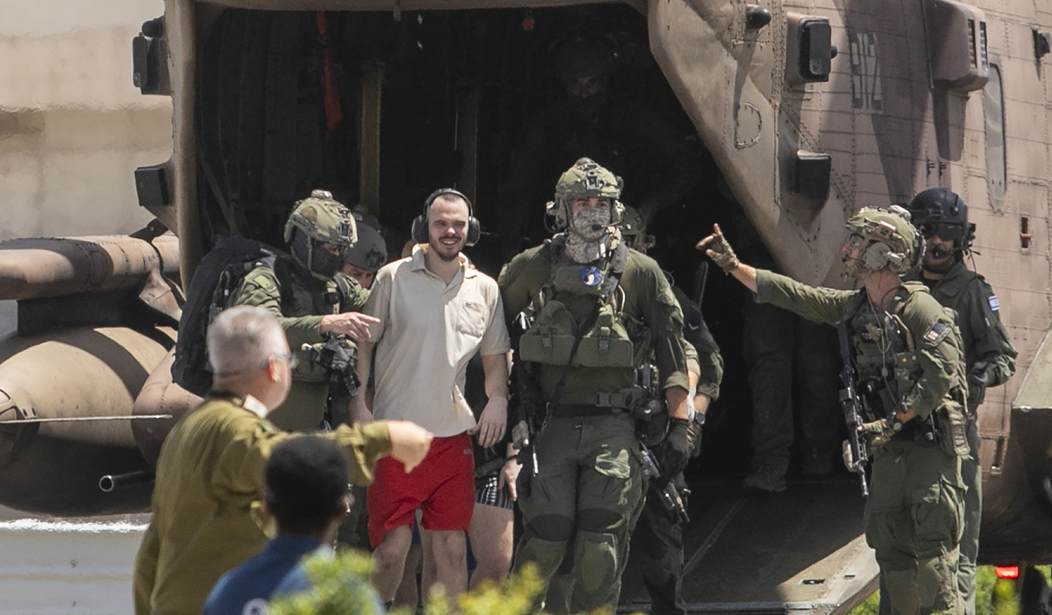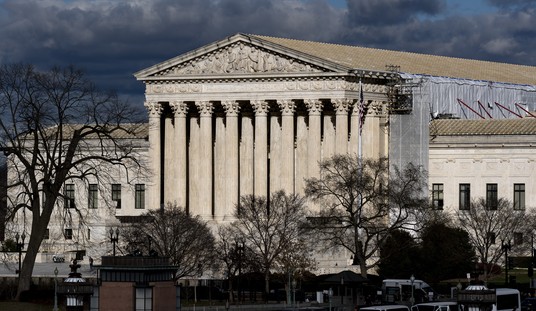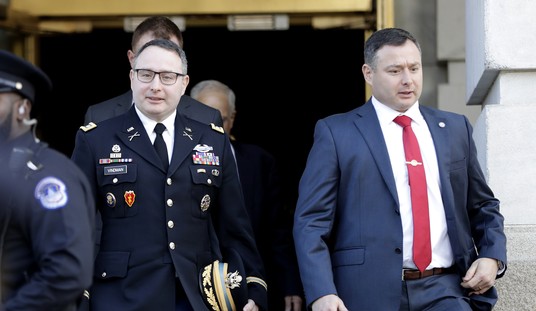Israel's daring rescue of four hostages being held by Hamas terrorists in Gaza last week involved undercover surveillance and a raid straight out of an action movie — and a new report reveals how Israeli forces infiltrated the city of Nuseirat, located the hostages, and exfiltrated them under heavy fire from an unexpectedly large number of terrorists.
Plans to rescue the hostages started when Israeli officials received intelligence on May 12 regarding the four hostages being held in Nuseirat, reports Elon Perry in The Jewish Chronicle. "From that day on, every branch of Israeli intelligence was focused on the area 24 hours a day, 7 days a week, to locate the exact location."
If you've seen the Israeli TV show "Fauda," you're familiar with Israel's undercover Mista’arvim units. One was sent to Nuseirat to verify the intelligence and confirm the hostages' location. For more than two weeks, unbeknownst to everyone around them including Hamas terrorists, the Mista’arvim unit worked to confirm where the hostages were being held — and on which floor — in two adjacent buildings.
The intelligence gathered by the Mista’arvim unit was kept "top secret" and "[e]ven the other forces in Gaza, including senior commanders, were not informed about it," Perry reveals. "As the War Cabinet discussed options, the preparations and training for the operation began."
More from the incredible inside story recounted by Perry:
In order to finally verify the information and to prepare the ground for the operation, another team of undercover soldiers (including several women dressed in hijabs and long black dresses) was sent into the Nuseirat refugee camp. Pretending to be two Gazan families looking for a large house in Nuseirat, they arrived in two cheap-looking old cars loaded with domestic items characteristic of those families displaced in the Strip, such as mattresses and clothing identical to those of the locals.
When the residents of the Nuseirat camp asked the undercovers where they came from and what they were looking to do in Nuseirat, they replied that they had fled from Rafah due to "deadly shelling from the Israeli army", and decided to rent a house in the area.
[...]
A few days later, after settling into the house and getting to know the area, including shopping at the local market, and realising that they did not arouse suspicion, the undercovers began their mission: verifying the location where the hostages were held. They split into two teams. One team consisted of two commandos, a man dressed as a typical Gazan local and a woman dressed in a long black dress and hijab. They began marching down the street towards the ‘Al-Auda’ medical centre where, in a nearby residential building 200 metres from the hospital, Noa Argamani was held. The undercovers walked with complete confidence as if they were walking down a street in Tel Aviv. To add to their authenticity, they stopped from time to time at stalls along the sides of the street, showing interest in the products while complaining about the difficult situation in Gaza. This was done in fluent Arabic with a perfect Gazan accent. Behind them, walked four more undercover men, armed to give backup in case a ‘Fauda-like’ situation occurred (Fauda in Arabic means unexpected chaos).
The second team consisted of four female soldiers dressed as typical Arab women (one feigning being pregnant) carrying plastic bags full of food products and vegetables. They walked in two pairs (a young Muslim woman is not allowed to walk around alone) towards a nearby residential building, where, on the third floor, the three male hostages were held. Behind them walked four more undercover men armed to give them backup.
Recommended
The undercover units confirmed the location of the four hostages again with leaders in Israel and the War Cabinet decided to move forward with plans for a rescue operation. Models of the two "civilian" homes where the hostages were being held were constructed for 28 "Yamam" unit commandos to rehearse movements, entry, and exfiltration. "After three days of training, the commander of the force informed the IDF Chief of Staff...that they were ready to carry out the operation," Perry recounts. Israeli Prime Minister Benjamin Netanyahu was informed and he green-lit the daring plan.
Israel ordered all but four of the covert operators inside Gaza to depart Nueirat "without arousing suspicion" before the raid occurred while the remaining members continued surveilling the buildings "to make sure that the hostages were not transferred to another location."
The morning of the operation, the "Yamam" commandos split into two teams and moved closer to the buildings where "civilians" were holding Israeli hostages. "To maintain the element of surprise as much as possible, the unit's fighters travelled hiding in two trucks," writes Perry.
The order to launch came at 11:00 a.m. as a live feed from airborne IDF assets "transmitted directly to the screens in two command and control rooms in Israel from which the operation was being overseen." The commandos "stormed both buildings simultaneously in full coordination."
After neutralizing the terrorists holding Noa Argamani and rescuing her in under six minutes, she was whisked to a helicopter that flew her back to Israel.
I have no words.
— Yaari Cohen (@YaariCohen) June 13, 2024
An interview with two of the Elite Yamam fighters who rescued Noa Argamani, the first thing she asked about was her mother....
subtitled by me. pic.twitter.com/hFbeJre3AN
In the second building where three Israeli hostages were being held, things "became complicated," Perry explains:
They were held in the home of Dr Ahmed al-Jamal, a medical doctor, who was a Hamas activist. His son, Abdullah, a journalist who had written for Al-Jazeera, was also staying in the apartment.
Some of the commandos used a ladder to enter directly into the room where the three hostages were held. This coincided with the entry of the rest of the force who came up the stairs from the main entrance of the building.
But Commander Arnon Zamora's team, which broke into the apartment at the head of the force, encountered massive fire from around thirty Hamas terrorists in the apartment They fired with machine guns, threw grenades and some even fired rocket-propelled grenade missiles at the surprised Israelis. This is how Arnon Zamora was killed.
The fact of the presence of 30 terrorists in the apartment had not been known to the undercover teams who had reported the information about the hostages’ location back to Israel. It is assumed that the terrorists arrived at the apartment only that morning or the night before, to strengthen the guarding of the three hostages.
Israeli forces, while unaware of the large number of terrorists in the second building, still overcame the challenge. "The three hostages had to hide in the bathroom of the apartment, protected by several Israeli fighters, during the battle," Perry continues. After Commander Zamora was hit, "three medics and a doctor leant over him, under heavy fire, trying to save his life."
"We came to rescue you. Be calm"
— Aviva Klompas (@AvivaKlompas) June 10, 2024
Dramatic helmet footage showing the rescue of 3 hostages from captivity in Gaza.
pic.twitter.com/r7I9RM3EkA
Despite being outnumbered in the small two-room apartment, Israeli forces eliminated all the terrorists inside.
While the battle raged inside, "dozens of terrorists emerged from the tunnels around the building and began to fire at the Israeli fighters with machine guns and RPG missiles," making getting out of the second building another dangerous movement. "The Israelis started making their way out of the building (several of them carrying Arnon Zamora on a stretcher), running through smoke-filled alleys and the nearby market which was crowded with thousands of Gazans who would not have hesitated to lynch them," notes Perry.
The plan called for this group to exfiltrate in a waiting rescue vehicle but it was struck by the terrorists' RPGs — and "Plan B" was activated, explains Perry: "a daring operation under massive, very close fire from the enemy, covered by Israeli fire from ground, sea and air."
Assistance for the pinned-down forces and hostages came in the form of tanks along with hundreds of infantry soldiers and paratroopers who "charged on foot into the refugee camp, fighting face-to-face battles with Hamas terrorists while navy ships covered from the west and air force helicopters from the east. Fire from the air hit the terrorists just ten metres from the Israeli soldiers." Talk about precision.
Plan B succeeded in clearing an escape route for the Israeli forces and hostages who were taken by helicopter to Israel. Hamas officials in Gaza claims "274 Palestinians were killed" but the IDF counted 104 casualties, "all of whom were Hamas terrorists or armed civilians who collaborated with the terrorist organization."
Video released by the Israeli Air Force showing a chopper taking off from Gaza with three of the four hostages rescued in Saturday's operation. pic.twitter.com/48Wz8FJmRq
— Spencer Brown (@itsSpencerBrown) June 8, 2024

























Join the conversation as a VIP Member